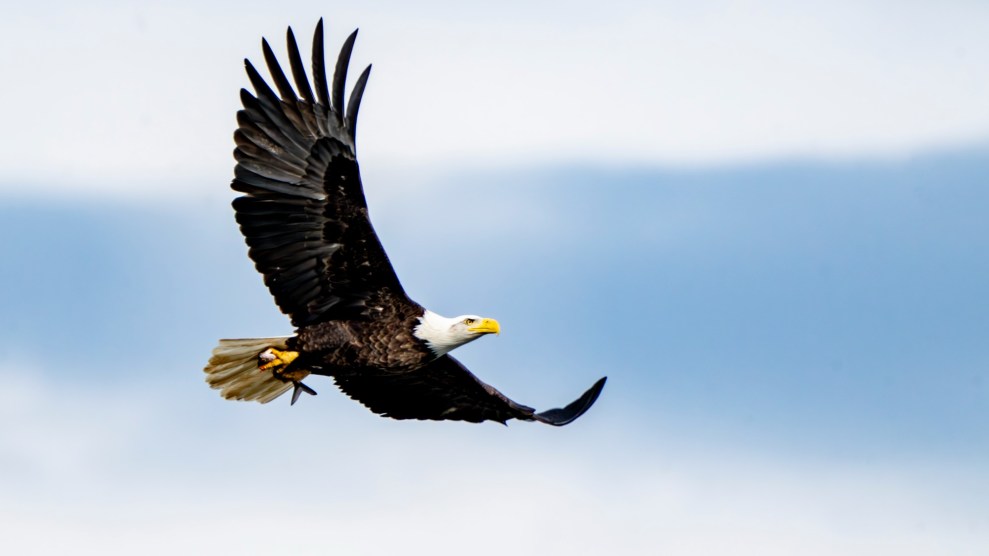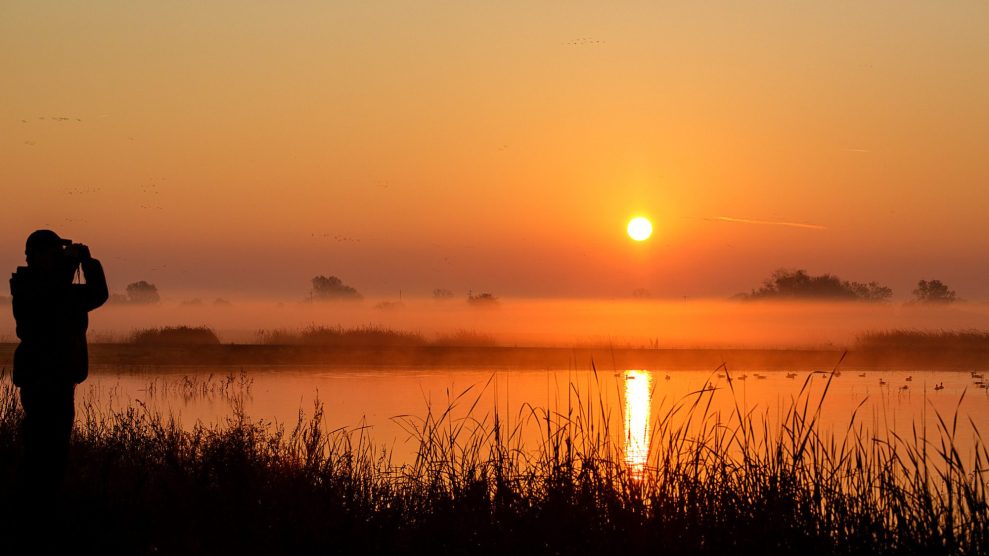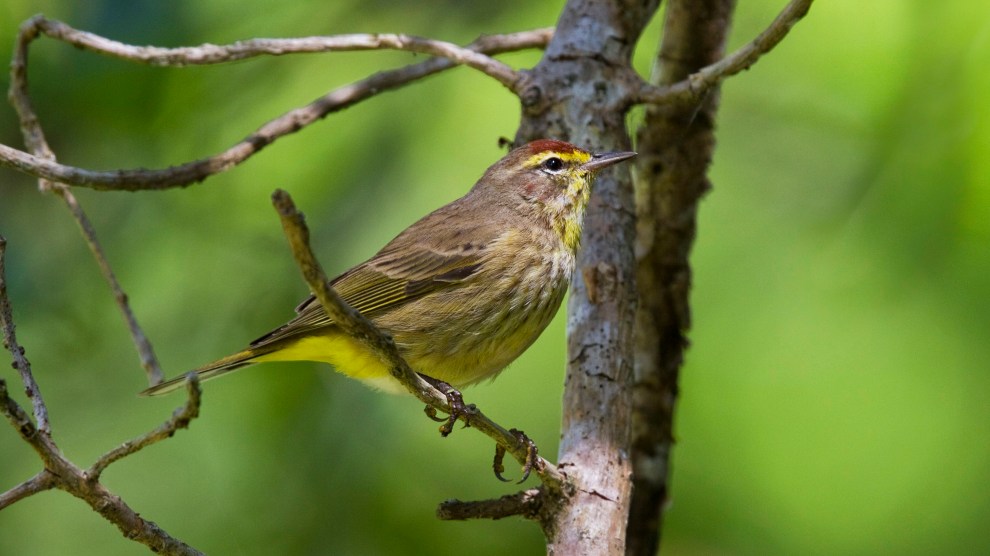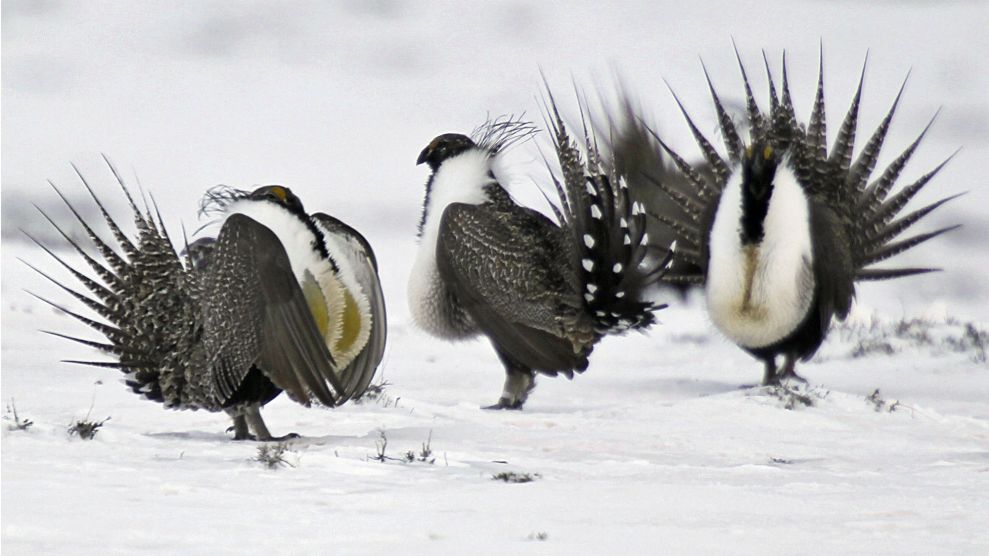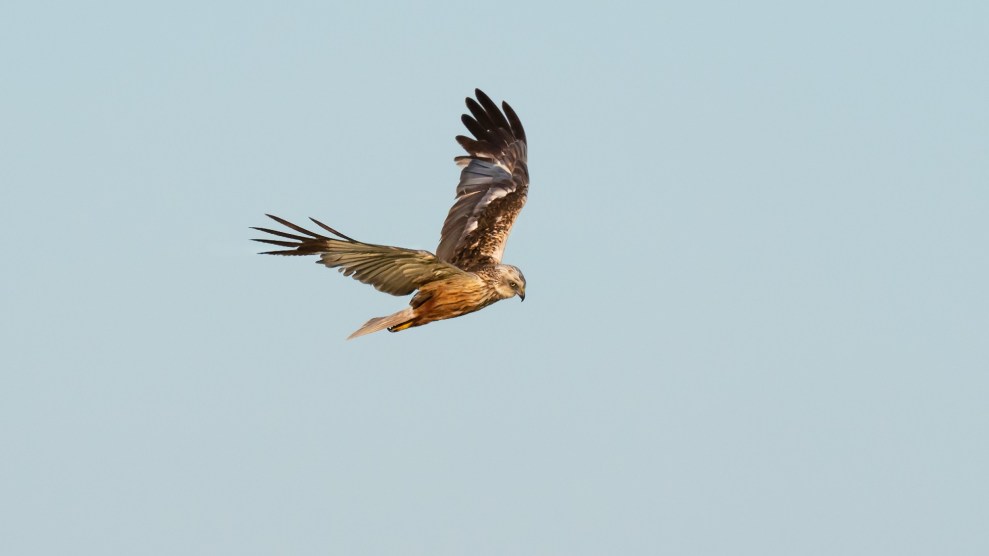
A male western marsh harrier (Circus aeruginosus) flies over a natural meadow near Dranske on the Baltic Sea island of Ruegen at dusk.Wolfram Steinberg/ZUMA
This story was originally published by the Guardian and is reproduced here as part of the Climate Desk collaboration.
In late 2023, 70-year-old birder Peter Kaestner was within striking distance of a goal that had never been accomplished: seeing more than 10,000 different species of birds in the wild.
Such a record had previously been unthinkable, but with new technology facilitating rare bird sightings, improved DNA testing identifying a growing number of bird species, and public listing platforms making it easier to keep track of and share findings, more super-birders are inching towards the five digits.
Just as Kaestner approached the finish line for his record 10,000 birds, though, a previously unknown competitor by the name Jason Mann flew in out of nowhere to snatch the record out from under him.
The mystery birder seemed to have uploaded a backlog of thousands of species he had seen over several decades to now-defunct birding site Surfbirds.com, listing more than 9,000 birds over the course of a few months in a move that took Kaestner and others by surprise.
“Two people break 10,000 species, and on the same day? Can it be?” one incredulous birder posted in February.
Subsequent scrutiny of Mann’s claims and drama that ensued over their veracity shook the online birding community, which revolves around a small cadre of websites but has no centralized authority. The mad dash for who could log most birds called into question whether logs should be better moderated in a competition in which sightings are largely accepted in good faith.
“On the internet, you can post anything you want,” said Kaestner, who has generally declined to comment on the veracity of Mann’s listings. “The question is, when this is not hurtful or illegal, it’s just someone making a claim, who gets to say whether any particular claim is valid or not?”
Bird observation has come a long way since the ornithologist John James Audubon announced his goal to painstakingly document all the birds in North America through physical drawings, starting around 1820. With digital cameras, birds can now be captured in high-quality photos, and artificial intelligence technology can identify birds by their calls. While in the past, birders kept lists of “lifers”—the word for a new-to-you species—in paper notebooks, most hobbyists today use online platforms to track and share their sightings. Popular apps including iBird, iGoTerra and eBird allow hobbyists to see where rare birds have been found and try their luck at spotting them.
These platforms are now at the center of the controversy between the two birders.
There is a broad range of intensity in the practice of observing birds. Casual hobbyists are known as “bird watchers,” while seeking to log species in a more competitive manner is known as “birding.” Those who log large numbers of species and rare sightings call themselves “listers.” Those like Kaestner who seek to break world records are known as “big listers.”
Given the dire rate of decline and extinction in bird populations, it may seem counterintuitive that the 10,000-bird milestone was not achievable until now. But this can be largely attributed to changes in bird taxonomies in the last century, including over the course of Kaestner’s birding career.
“When I was in college, the very first book listing the birds of the world was compiled and published, and it had about 8,600 birds,” he said. “Seeing 10,000 birds was mathematically impossible.”
Taxonomies change when the understanding of birds evolve and “split” existing species into two species (or, less commonly, “lump” them into one). In 2023, for example, the northern goshawk species was split into two—the Eurasian goshawk (Accipiter gentilis) and American goshawk (Accipiter atricapillus)—after substantial differences were discovered in the birds’ genetics and vocalizations. The speed at which species are splitting appears to be accelerating as advances in genetics make it easier to measure the biochemical markers that delineate species.
The variability in recognized species represented a complicating factor in the quest to hit the 10,000-bird milestone. The popular platform eBird only uses the Clements Checklist of Birds of the World, while iGoTerra offers users both the Clements and International Ornithological Community’s (IOC) World Bird List taxonomies. The latter recognizes 189 more species of birds, making larger lists more attainable.
Kaestner uses both sites, but he reached his record using the IOC taxonomy, which he logged through iGoTerra. Because eBird data is used for science and conservation, sightings are moderated by volunteers around the world. If a user claims to have seen a rare species, or an unusual number of a species, a moderator may reach out for more information or request photos or audio recordings as proof.
iGoTerra, on the other hand, does not fact-check sightings. The platform allows logging of plants insects and other species in addition to birds. eBird’s focus on collecting and using large amounts of citizen science data makes moderation more consequential, whereas iGoTerra is more “geared towards the individual,” said Björn Anderson, iGoTerra’s vice-president.
“iGoTerra is more of a gentlemen’s agreement,” he said. “We provide the tools for you to keep track, but it’s up to you to determine what you have seen.”
That policy created a “very delicate situation” in the race towards 10,000 species, said Anderson. iGoTerra’s official policy was to stay out of the debate, relying on the transparency of its product to let those following the drama make their own decisions.
Kaestner, who lives in a suburb of Baltimore, has been watching birds as long as he can remember, he says, joining his older brother birding as early as age four. The career diplomat took advantage of his travels around the world to see as many species as possible, setting a record in 1986 for being the first person to observe an example of every bird family in the wild—a feat that was recognized by Guinness World Records. He built up a reputation in the birding community as he publicly shared many of his lists and photos.
In 2018, Kaestner realized he had surpassed 9,000 lifers and began pursuing the 10,000-bird milestone in earnest. His quest was highlighted in a May 2023 article in Outside magazine, as well as on his widely followed Facebook account. He explained his goal, how he planned to accomplish it, and his timeline—a move he now questions.
“I realize now that by publishing that, I may have been putting a target on my back,” he said. “Little did I know Jason Mann would be aiming for it.”
Mann, a little-known US birder living abroad, had recently appeared on the scene, posting occasionally on the bird forum Surfbirds.com. According to his LinkedIn profile, Mann is a medical doctor and healthcare investor based in Hong Kong. In October 2023, he published a list detailing more than 9,000 species he said he had seen over the course of his lifetime.
The move surprised the birding world. Nobody, including Kaestner, had ever heard of him—a rare occurrence in a close-knit community in which the top players are well-recognized. Having been in the game for decades, Kaestner knew most of his high-level peers personally, on many occasions having taken birding trips with them in the spirit of friendly competition. Mann did not respond to multiple requests for comment on this story.
The entry of a dark horse into the race sent Kaestner scrambling. He quietly moved up a planned trip to Taiwan, where he hoped to see a handful of final species. Mann was adding nearly a dozen new species a day. The sprint was on—and on February 9, 2024, having rushed to the Philippines for another birding trip, Kaestner crossed the finish line with the sighting of an orange-tufted spiderhunter, a small bird with a long curved bill and a penchant for banana plants. Kaestner immediately posted the sighting to birding apps and Facebook, with photo proof. He thought he had won.
Stunningly, Mann claimed to have seen his own 10,000th species in Colombia, a chestnut-bellied flowerpiercer, just hours before Kaestner on the same day. Mann’s achievement was later announced on the blog of a Colombian nature trip service in a post authored by Mann himself.
The shocking upset prompted online sleuths in the birding community to take a closer look at Mann’s list, where they found “several dozen extremely fishy species” that, besides Mann, “no one has claimed to have seen for decades,” according to one post on BirdForum, a community for birders with more than 100,000 visitors a month. The post had more than 400 comments discussing the validity of Mann’s sightings. Species Mann claimed to have seen included the Manipur bush quail and the new Caldonian nightjar, neither of which had been spotted since the 1930s.
“Either this guy is the luckiest birder alive, having rediscovered several lost species, or his list is not to be trusted,” one member auditing Mann’s list wrote.
For his part, Kaestner took Mann’s sightings in stride, congratulating him and stating he would focus on celebrating his own accomplishment. “I was not involved in disproving Jason, or criticizing him publicly,” he said. “I have no idea if he is legitimate, misguided, or a complete fraud.”
After parts of his list were discredited, Mann ultimately posted on BirdForum and sent Kaestner an email conceding defeat. The Colombian blog where his accomplishment was first cited was taken down and an apology from the company was appended. Mann said that while he is comfortable with “>99% of the list” he uploaded, he “recognize[s] that in haste there were a few oversights.” Given the errors, he said: “I think it best to put my support behind Peter as the first birder to 10,000.”
“I don’t want there to be any question, and in my view he is extremely deserving,” Mann wrote. “I celebrate Peter and other world-class listers, and do not consider myself in competition with any of them.”
As the drama has died down, Kaestner is still traveling, and still birding. While competition and achieving birding records are thrilling, he said they are just a small part of what draws him to birding.
“Being recognized for having worked so long and so hard at something is a treat—you can’t deny it, but it’s not the reason I birdwatch,” he said. “I love to travel, I love the adventure of going to unusual places, I love observing bird behavior. I love teaching people about birds. Having my 15 minutes of fame is just a bonus for me.”
Mann has taken his iGoTerra list private in the aftermath of the controversy. In a post to BirdForum identifying himself, he conceded that he “made some errors when inputting my sightings into iGoTerra” and explained that he is “new to the public side of big listing.” He stated that it had been a “massive effort” to collate all of his notes “after 37 years of birding almost everywhere.” The effort was complicated, he noted, by the varying taxonomies and the fact that SurfBirds.com became unstable in the midst of the race, forcing him to migrate to iGoTerra.
“To me it was a real privilege to have such a close, neck-and-neck race at the end,” he wrote. “My hope is that any associated publicity helps move birding forward, raising awareness for more people to enjoy and protect nature.”
With both birders’ lists on full display, Kaestner’s own logs came under scrutiny following the 10,000-bird achievement, ultimately leading him to remove three species. He said he had already removed the birds in question from his eBird listings but forgot to remove them from iGoTerra. One of those sightings was called into question more than three years after the fact, he said, when new research revealed it was impossible he could have seen that species in the location where it was logged. His final number of sightings still stood above 10,000.
“If I’ve made a mistake, very often it’s based on knowledge of the bird at the time,” he said. “Science is all about advancing knowledge, and as the knowledge of the bird changes, if I get evidence I made a mistake, I am more than willing to take a bird off my list.”
Anderson said iGoTerra does not plan to change the way it moderates the platform, but that the recent events have inspired more transparency and scrutiny of lists, which he said is a “very good thing.” He says public validation can be more important than that of an individual reviewer because there is more knowledge to pull from. At the end of the day, he added, the competition is meant to be friendly.
“Even if two top birders are neck and neck, I guarantee you they would help one another to get a new lifer, or even share a car on a trip to see a rare bird,” he said. “I think that is pretty unique, and it’s part of the beauty of this competition.”
Kaestner’s list, following his removal of three species that were questioned, now stands at 10,002 birds. He doesn’t have a new goal in mind and said for now he is focusing on bird conservation and leading educational trips. The response to the controversy affirmed for him why he is involved in birding to begin with: people he bumped into on bird-watching trips decades ago came to his defense.
“Some birders don’t understand that birding is a team sport,” he said. “Getting information from others, sharing information, developing relationships with people—you can’t be a complete lone wolf. It’s always been a team sport.”
